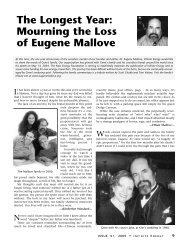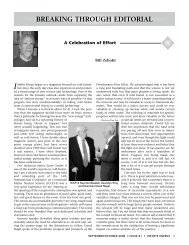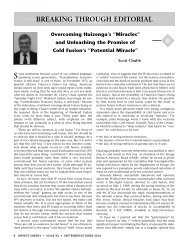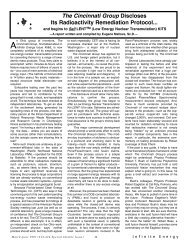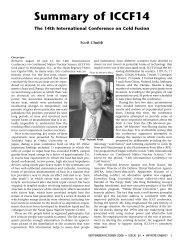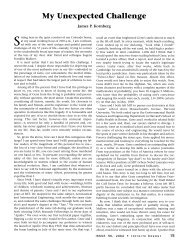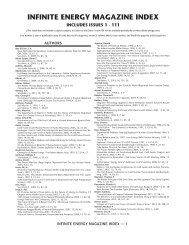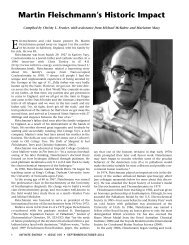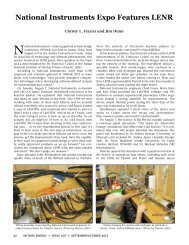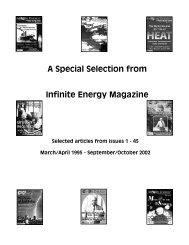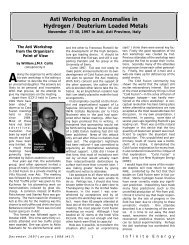MIT and Cold Fusion: A Special Report - Infinite Energy Magazine
MIT and Cold Fusion: A Special Report - Infinite Energy Magazine
MIT and Cold Fusion: A Special Report - Infinite Energy Magazine
Create successful ePaper yourself
Turn your PDF publications into a flip-book with our unique Google optimized e-Paper software.
Nobel Laureate Julian Schwinger said in March 1990, “It is<br />
no longer possible lightly to dismiss the reality of cold fusion.”<br />
After long <strong>and</strong> careful study of this controversy in both its scientific,<br />
media, <strong>and</strong> political dimensions, I am personally convinced<br />
at greater than a 99% confidence level that cold fusion is<br />
real—both the nuclear emanations that have been reported <strong>and</strong><br />
the excess enthalpy that seems to emerge from various experiments.<br />
The erratic nature of the phenomena —the lack of reproducibility<br />
“on dem<strong>and</strong>”—has clearly been the central obstacle<br />
to acceptance in the scientific community, but extraneous<br />
“political” <strong>and</strong> programmatic factors have also played a role. It<br />
would seem, however, that reproducibility—no doubt a function<br />
of certain critical atomic structure <strong>and</strong> composition factors<br />
in the test systems—is getting to be less <strong>and</strong> less a problem.<br />
Two unusual documents that have come to my attention are<br />
only the most recent in a cascade of information that is now<br />
emerging in the field. Physicist David Worledge of the Electric<br />
Power Research Institute (EPRI), who has just returned from a<br />
trip to the Soviet Union, supplied me with the astounding report<br />
of the “Workshop on Nuclear <strong>Fusion</strong><br />
Reactions in Condensed Media,” which<br />
was held at a world-class high-energy<br />
physics center under the sponsorship of<br />
the USSR Academy of Sciences, among<br />
other prestigious scientific organizations.<br />
This is extraordinary because this<br />
heretofore unknown but suspected<br />
level of effort on cold fusion in the<br />
Soviet Union gives an independent<br />
check on some of the nuclear effects<br />
work in the U.S. (I regret to say that in<br />
Dr. Worledge of EPRI<br />
the present atmosphere of hostility to<br />
cold fusion in the U.S., such a conference<br />
would now be unthinkable at places like Brookhaven<br />
National Laboratory <strong>and</strong> Fermilab.) Noteworthy is the claimed<br />
increasing levels of reproducibility in the experiments, which<br />
incidentally, is also happening in the U..S—e.g. at Los Alamos<br />
National Laboratory <strong>and</strong> at SRI International in Palo Alto, which<br />
has carried out reproducible excess energy production in electrochemical<br />
cells.<br />
The other paper comes from my colleague,<br />
Dr. M. Srinivasan, Head of the<br />
Neutron Physics Division at the Bhabha<br />
Atomic Research Center, BARC, in<br />
India. This is his recent excellent summary<br />
of the experimental evidence for<br />
cold fusion, which BARC has played a<br />
major role in supplying. Read it <strong>and</strong> perhaps<br />
be amazed, as I have been. I was<br />
Dr. M. Srinivasan<br />
of BARC<br />
already aware of most of the results that<br />
he cites, but he assembles it so nicely.<br />
As for experimental work here at <strong>MIT</strong><br />
in this exciting new field, I regret to tell you that it does not exist.<br />
After the initial brief but intense period of experimental assessment<br />
in the spring of 1989 by an interdisciplinary team drawn<br />
from the Plasma <strong>Fusion</strong> Center <strong>and</strong> from the Chemistry Department,<br />
led by PFC Director Professor Ronald R. Parker <strong>and</strong> then<br />
Chemistry Department head, Professor Mark S. Wrighton, to my<br />
knowledge, nothing further has been done along experimental<br />
lines. It is notable, however, that researchers in several departments<br />
at <strong>MIT</strong> have continued a strong interest in the field.<br />
An atmosphere of hostility, analogous to the editorial position<br />
on cold fusion of a certain well-known scientific journal<br />
[Nature], is prevalent. I do not feel that <strong>MIT</strong>’s best interests are<br />
served any longer by unwarranted ignoring of the mounting<br />
experimental evidence for cold fusion. It seems to me essential<br />
that members of the <strong>MIT</strong> community reassess the experimental<br />
findings that have come <strong>and</strong> are coming from both domestic <strong>and</strong><br />
foreign laboratories. To do any less would be, it seems to me, an<br />
abdication of scientific responsibility, not to mention a possible<br />
longer range injury to the reputation of <strong>MIT</strong>. It is even possible<br />
that the international competitiveness position of the U.S. might<br />
be at stake, something we here have given much attention to.<br />
There is strong evidence, for example the enclosed Matsushita<br />
Corporation patent application, that Japanese laboratories are<br />
devoting their considerable talents to this field. (I believe it probable<br />
that a major Japanese Corporation may be funding the work<br />
of Drs. Fleischmann <strong>and</strong> Pons now in France.) [Editor’s Note: That<br />
corporation turned out to be IMRA, an affiliate of Toyota Corp.—EFM]<br />
Basically, I think the train is leaving the station, <strong>and</strong> <strong>MIT</strong> is not<br />
on it. This deeply troubles, saddens, even embarrasses me —as<br />
an alumnus who cares deeply about <strong>MIT</strong> <strong>and</strong> its image. May I<br />
suggest that you assemble very soon <strong>and</strong> publicly a panel of <strong>MIT</strong><br />
scientists <strong>and</strong> engineers to consider <strong>and</strong> evaluate the status of<br />
research on “nuclear reactions in deuterium infused metals.”<br />
(There is no need to call it the politically charged, “cold fusion,”<br />
even though that may well be what it is.) I can imagine the composition<br />
of such a panel, who would hear from researchers both<br />
within <strong>and</strong> from outside <strong>MIT</strong>—including from foreign countries.<br />
Obviously, <strong>MIT</strong>'s thoughtful skeptics (e.g. Dr. Richard Petrasso)<br />
as well as proponents of these phenomena (e.g Professor Peter<br />
Hagelstein) should be aboard. As a chairperson, I would offer<br />
the names of three outst<strong>and</strong>ing scientists, who could guide<br />
deliberations in a fair manner: Professors Philip Morrison,<br />
Jerome Friedman, or Henry Kendall. Because of my knowledge<br />
of the field through being a conduit of information, I would be<br />
honored to assist any such panel in its deliberations.<br />
I have sent a copy of this letter to your predecessor, Professor<br />
Paul Gray, with whom I have discussed cold fusion earlier, in<br />
the days when the controversy arose. My deep appreciation to<br />
you for carefully considering this suggestion. I look forward to<br />
discussing the idea further with you, if you feel that it has merit,<br />
<strong>and</strong> of course I hope you will.<br />
Sincerely, Eugene F. Mallove<br />
Exhibit J<br />
Eugene Mallove’s Letter to Dr. Stanley Luckhardt<br />
April 29, 1991<br />
My written request to Dr. Luckhardt for clarification <strong>and</strong> other<br />
data was rebuffed.—EFM<br />
Eugene F. Mallove, Sc.D., Chief Science Writer, <strong>MIT</strong> News Office,<br />
Room 5-111, Lecturer in Science Journalism, Department of Humanities<br />
Dr. Stanley C. Luckhardt<br />
Room 36-293<br />
Dear Stan:<br />
Glad that you were able to come to Dr. Fred Mayer’s [cold fusion]<br />
seminar last week <strong>and</strong> ask some good questions. It’s nice to have an<br />
alternate theory to compare with Peter’s [Hagelstein’s] ideas.<br />
I have been meaning to submit a short note to the Journal of <strong>Fusion</strong><br />
<strong>Energy</strong>, a comment of sorts about the <strong>MIT</strong> experiments in the spring of<br />
1989 <strong>and</strong> where they fit into the big picture. I would mainly be addressing<br />
the calorimetry issue <strong>and</strong> in that regard would want to refer to both<br />
your perspective <strong>and</strong> to that of Dr. Noninski. I realize that there are two<br />
pieces of information that it would be helpful, though not essential, for<br />
me to have: (A) The precision <strong>and</strong> assumed accuracy of each of the measuring<br />
devices (current, voltage, <strong>and</strong> temperature) <strong>and</strong> (B) The plot of<br />
the heater power versus time for the light water comparison cell run that<br />
corresponds to the D 2 O heater power plot presented in the PFC report.<br />
Thanks in advance for your help, <strong>and</strong> I look forward to sharing with<br />
you some of my ideas, once I get them on paper.<br />
Sincerely, Eugene F. Mallove<br />
29 <strong>Infinite</strong> <strong>Energy</strong> • ISSUE 24, 1999 • <strong>MIT</strong> <strong>Special</strong> <strong>Report</strong>



